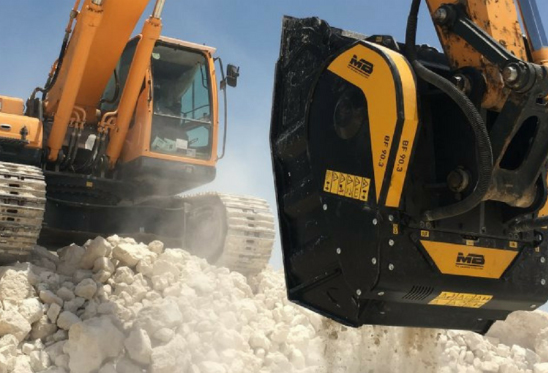Thanks to new innovations and heightened awareness, construction has grown to become a much less dangerous place to work than in previous years. An industry once blighted by incidents and fatalities has taken great strides forward in addressing many issues to provide a much safer working environment.
Risk assessments identify potential problems and are conducted prior to any work taking place; they may highlight areas of concern such as:
- Moving objects
- Noise
- Vibration
- Manual handling
- Hazardous substances (dust, cement, solvents, lead etc.)
The rise and use of excavator attachments has had a positive effect on all five of the safety aspects mentioned above and has helped to maintain a better safety record, with significantly fewer accidents and near miss events being recorded as a result. Below we discuss just a few of the safety benefits gained by using excavator attachments:

Protection from flying debris
Major safety improvements have resulted when excavator attachments are used in preference to manual tools; one reason for this being the operator works within the protective confines of the excavator cab and is therefore protected from any flying or falling debris. Modern excavator cabs are increasingly fitted with guards and have toughened polycarbonate windows that provide full protection and emergency egress if necessary.
Using a powerful excavator attachment delivers a two way win: it allows work to progress at a much faster pace, and comes with a much higher degree of safety.
Decreased exposure to dust
Debris of all kinds are hazardous to the construction worker, and health issues brought about by regular and excessive exposure to dust can be some of the most debilitating. Construction workers have a high risk of developing conditions such as silicosis, lung cancer and chronic obstructive pulmonary disease (COPD). Switching to excavator attachments however, effectively separates the operator from these external dangers by providing an enclosed working environment within the cab that may also be equipped with specialist dust filters.
Hand Arm Vibration Syndrome (HAVS)
Tingling fingers, numbness and loss of grip, as well as tendon and nerve damage are all well documented symptoms of HAVS and many claims for compensation or negligence have been filed over the years. The prolonged use of manual tools in construction, such as compactors and hydraulic breakers, are often the root cause of this condition.
The Control of Vibration at Work Regulations 2005 (HSE) gives guidance on reducing or eliminating the effects of vibration on employees which includes: ‘isolating workers from tasks creating vibration; e.g. by using a breaker attachment for an excavator or remote controlled equipment instead of a hand-held breaker’ (HSE, 2005)

Manual handling
Manual handling on construction sites is fraught with many health and safety risks. Many of these tasks require the contractor to support and move heavy loads, often in awkward positions and over rough, uneven ground. The opportunity to use an attachment eliminates those risks and can prevent operators from developing musculoskeletal disorders. Piletec ’ VibroSafe Quick Hitch Adaptor, for example, alleviates all manual handling and offers the safest possible solution when working with Excavator Mounted Vibratory Piling Hammers (EMVs).
Building a safer future
Groundforce recognise that building a safer future for everyone involved in the construction sector is of paramount importance and meets this challenge by supplying a comprehensive range of excavator attachments all designed to get the job done quickly and, more importantly, ensuring that at the end of each working day all employees and subcontractors are able to return home safely.